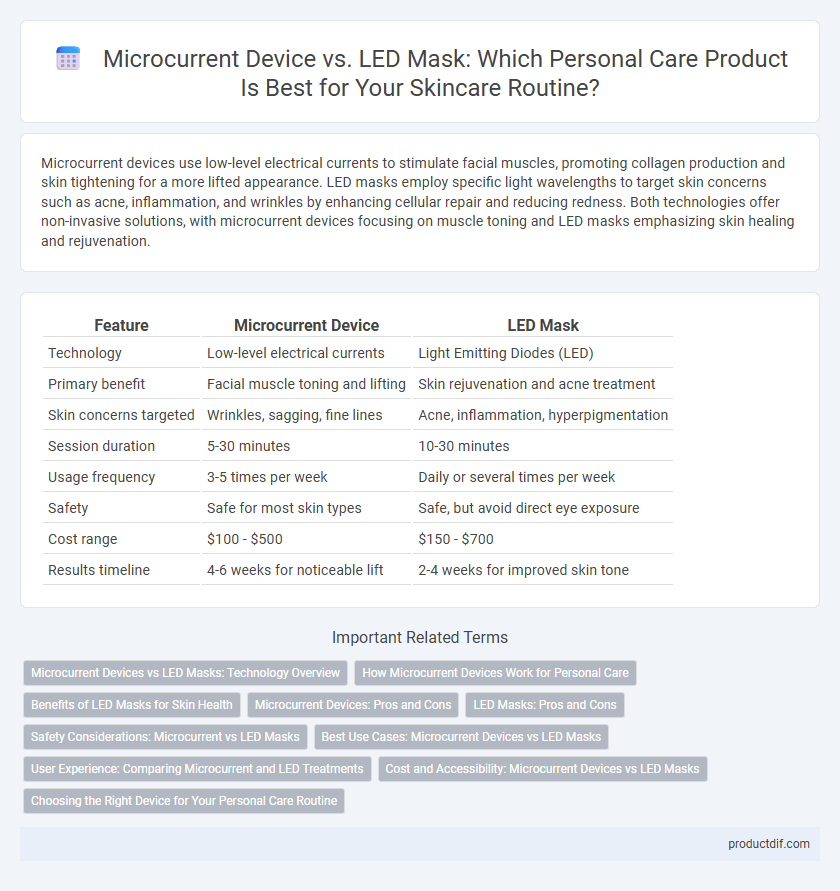Microcurrent devices use low-level electrical currents to stimulate facial muscles, promoting collagen production and skin tightening for a more lifted appearance. LED masks employ specific light wavelengths to target skin concerns such as acne, inflammation, and wrinkles by enhancing cellular repair and reducing redness. Both technologies offer non-invasive solutions, with microcurrent devices focusing on muscle toning and LED masks emphasizing skin healing and rejuvenation.
Table of Comparison
| Feature | Microcurrent Device | LED Mask |
|---|---|---|
| Technology | Low-level electrical currents | Light Emitting Diodes (LED) |
| Primary benefit | Facial muscle toning and lifting | Skin rejuvenation and acne treatment |
| Skin concerns targeted | Wrinkles, sagging, fine lines | Acne, inflammation, hyperpigmentation |
| Session duration | 5-30 minutes | 10-30 minutes |
| Usage frequency | 3-5 times per week | Daily or several times per week |
| Safety | Safe for most skin types | Safe, but avoid direct eye exposure |
| Cost range | $100 - $500 | $150 - $700 |
| Results timeline | 4-6 weeks for noticeable lift | 2-4 weeks for improved skin tone |
Microcurrent Devices vs LED Masks: Technology Overview
Microcurrent devices use low-level electrical currents to stimulate facial muscles, promoting collagen production and improving skin tone by enhancing cellular activity. LED masks rely on specific wavelengths of light to target skin concerns such as acne, inflammation, and aging through phototherapy that penetrates different skin layers. Both technologies offer non-invasive treatments, but microcurrent devices focus on muscle stimulation while LED masks emphasize light-based cellular repair and regeneration.
How Microcurrent Devices Work for Personal Care
Microcurrent devices use low-level electrical currents to stimulate facial muscles, promoting collagen production and enhancing skin tone and elasticity. These devices improve blood circulation and encourage cellular repair, resulting in reduced wrinkles and a more lifted appearance. Compared to LED masks, microcurrent technology offers active muscle engagement for targeted anti-aging benefits.
Benefits of LED Masks for Skin Health
LED masks stimulate collagen production and improve skin elasticity by delivering specific wavelengths of light that penetrate deep into the skin layers. They effectively reduce inflammation, acne, and hyperpigmentation, promoting a clearer and more even complexion. Unlike microcurrent devices, LED masks offer a non-invasive treatment option that supports skin healing and rejuvenation without discomfort.
Microcurrent Devices: Pros and Cons
Microcurrent devices stimulate facial muscles using low-level electrical currents to enhance skin tone, reduce wrinkles, and promote collagen production. They offer targeted, non-invasive treatment with immediate tightening effects but require consistent use and professional guidance to avoid muscle fatigue or skin irritation. Compared to LED masks, microcurrent devices provide muscle lifting benefits but may be less effective for addressing redness and inflammation.
LED Masks: Pros and Cons
LED masks offer targeted skin treatments using varying wavelengths of light to address issues like acne, inflammation, and signs of aging. Their advantages include non-invasive application, customizable light settings, and improved collagen production, while drawbacks involve extended treatment times and the need for consistent use to see visible results. Users should consider skin sensitivity and consult with dermatologists to avoid potential irritation or ineffective outcomes.
Safety Considerations: Microcurrent vs LED Masks
Microcurrent devices deliver low-level electrical currents that require proper usage to avoid skin irritation or muscle discomfort, making safety protocols essential for sensitive skin types. LED masks use specific wavelengths of light to target skin concerns and generally present minimal risk, but it's crucial to avoid overexposure and follow manufacturer guidelines to prevent eye strain or skin redness. Both devices necessitate thorough understanding of user instructions and contraindications, especially for individuals with pacemakers, epilepsy, or photosensitivity.
Best Use Cases: Microcurrent Devices vs LED Masks
Microcurrent devices excel in muscle toning and facial contouring by stimulating underlying facial muscles to improve skin firmness and reduce fine lines. LED masks deliver targeted light therapy using specific wavelengths to address acne, inflammation, and collagen production, making them ideal for skin texture improvement and reducing redness. Choosing between the two depends on whether the primary goal is muscle stimulation and lifting or skin rejuvenation and treatment of dermatological concerns.
User Experience: Comparing Microcurrent and LED Treatments
Microcurrent devices offer a tactile, muscle-stimulating experience that many users find invigorating, promoting facial toning and lifting with noticeable firmness over consistent use. LED masks provide a soothing, hands-free treatment that targets skin concerns like acne, redness, and wrinkles through various light wavelengths, delivering relaxation alongside visible improvements. User preference often hinges on desired outcomes and time commitment, as microcurrent sessions may require more active participation while LED masks allow for multitasking during treatment.
Cost and Accessibility: Microcurrent Devices vs LED Masks
Microcurrent devices generally have a higher upfront cost, ranging from $150 to $500, while LED masks are often priced between $80 and $300, making them more accessible for budget-conscious consumers. Microcurrent technology requires targeted use with conductive gels and sometimes professional guidance, which can add to the overall expense and learning curve. LED masks offer ease of use and affordability through at-home options, increasing accessibility for daily skincare routines.
Choosing the Right Device for Your Personal Care Routine
Microcurrent devices stimulate facial muscles by delivering low-level electrical currents that enhance collagen production and improve skin tone, making them ideal for targeted lifting and contouring. LED masks use different wavelengths of light to address skin concerns such as acne, pigmentation, and inflammation, offering a non-invasive option for overall skin rejuvenation. Selecting the right device depends on your primary skincare goals: microcurrent technology suits those seeking muscle toning and anti-aging benefits, while LED masks are best for improving skin clarity and texture.
microcurrent device vs LED mask Infographic

 productdif.com
productdif.com